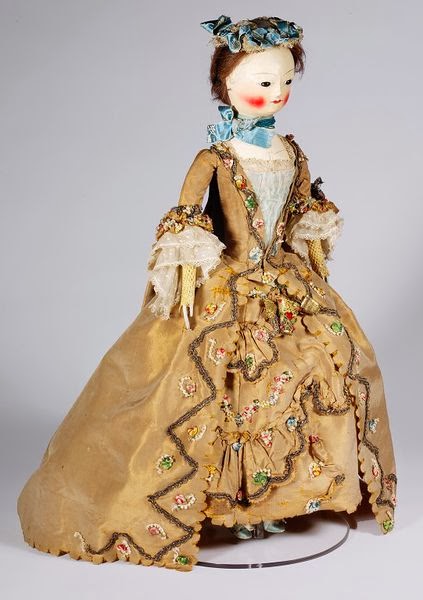Fashion has fascinated mankind long before people marvelled at the wondrous models in the very first fashion show, before the first magazines were issued and before the phenomenon of television and advertising as we know it today entered our lives. But even back then, clothing manufacturers sought to impress the public in order to create demand for their designs.
A look back at the history of fashion advertising
For 400 years, the upper classes interested in fashion relied on fashion dolls called Pandora. The miniature mannequins wore highly detailed, well-made costumes, which were copied and transferred onto precious fabrics by tailors - from patterned silk in the 15th century to empire gowns from the late 18th century. They were forever on the move - sailing across oceans and crossing enemy lines during wartime to ensure their owners were dressed in the latest fashion. Some even had their own diplomatic passports.
 Pandora fashion doll, ca. 1760-1770; Source: ncsu.edu
Pandora fashion doll, ca. 1760-1770; Source: ncsu.eduIn the late 17th century, fashion pictures emerged. It was during the reign of Louis XIV, King of France, whose court was the cradle of the modern fashion industry. With the advent of fashion magazines such as Le Mercure Galant (published from 1678), fashion images became widespread among the middle class. And this was probably the beginning of fashion as we know it today. The “seasons” began to be addressed, and new fashion trends were sought. Later came catalogues and then department stores. In 1848, Alexander Turney opened his Italian colossus, Marble Palace, on Broadway in New York. He lured customers with special discounts and fashion shows. He even used mail order.
With the advent of the European department store concept, ready-to-wear clothing became big business. Retailers introduced a number of marketing innovations - moving from haggling to fixed prices, focusing on customer service and experience, and brand building. The most prestigious brand of the time was that of Charles Frederick Worth, who has been called “the father of haute couture” and “the first fashion designer”, according to the Metropolitan Museum of Art. The Englishman founded his fashion house, House of Worth, in Paris in 1858 and was soon dressing the wealthiest Parisians, including the fashion-loving Empress Eugénie, in luxurious designs. Worth was a bold promoter who upended the existing relationship between tailor and customer. Previously, customers told tailors what to make, but customers came to Worth to be told what was in fashion. In addition, tailors were probably the first to sew brand labels into garments to raise awareness of their brands.
Today’s fashion industry
Logically, the brand building has continued to this day. Today, however, clothing designers face challenges that Worth couldn’t have imagined in his time. The fashion industry is one of the fastest changing sectors, where success requires not only aesthetic sensibility and a sophisticated product, but also sustained innovation, tremendous flexibility and a value-based attitude. Brands face a range of challenges that are emerging like mushrooms in the face of a changing market, increasing competition and rising customer expectations.
Consumer behaviour has changed significantly. Today’s buyer wants much more than an “outfit” - they want an experience. There is also increasing pressure for sustainability and ethics. Another big issue is market oversaturation. Brands today are competing not only with each other, but also with a huge number of online-only brands, global e-commerce platforms and ultra-fast fashion players. Platforms like Shein have fundamentally changed the game in the online space. They rely on extremely fast production, low prices and huge volume of products. Traditional clothing brands are trying to combat ultra-fast fashion with campaigns focused on sustainability, working conditions and authenticity. But will this be enough?
Television advertising as a powerful weapon in the competitive battle
Television, with its large reach, emotional impact and high credibility, allows clothing designers to build a brand in a wider cultural context. In addition, a TV campaign sends the signal “We are here, we are strong, we can afford a public space.” This is especially important for traditional brands facing competition from cheaper or unknown players. TV advertising is therefore far from being just about selling; it’s all about positioning. Television helps brands make themselves visible in a way that is credible, understandable and memorable. At a time when competition is increasing and loyalty is waning, these qualities are key to survival and growth. How are fashion giants using this powerful weapon? Let’s take a look at the advertising campaigns of two big rivals, Zara and H&M.
Zara - the silent queen of luxury
Zara, which is part of the Spanish Inditex group, traditionally competes with the clothing brand H&M. These are not direct advertising attacks. The brands fight each other through the aesthetics of campaigns, influence on trends and image. Zara relies on fashion relevance and a sleek, luxurious image. It consistently pays attention to aesthetics across all media channels. Its advertising campaigns are visually minimalist, often resembling editorials from Vogue. A great example is the Zara Studio Collection FW22 campaign. It is visually strong, almost wordless, with an emphasis on atmosphere and expressive styling.
Video: ZARA FW'22
Zara does not participate in direct advertising fights as a matter of principle. Its philosophy is “to be silent and look better”. However, the visual style of Zara Studio or SRPLS campaigns is often seen as a criticism of the “cheap fast fashion look”. Zara attacks its competitors with aesthetic superiority, but it is never explicit.
After Zara expanded its portfolio to include a cosmetics line, it introduced a campaign that combined icy elegance with a glam rock aesthetic.
Video: Zara Beauty
To celebrate Zara’s 50th anniversary, the brand released an elegant black and white ad spot in early May showcasing a spectacular collaboration with 50 of the world’s top models. “It's a unique celebration of creativity, longevity and love for fashion,” says the brand’s website.
Video: Zara - 50th Anniversary
Zara often collaborates with leading models and photographers on its advertising campaigns. For example, Lila Moss, daughter of model Kate Moss, has starred in Zara’s campaigns. The beauty of Lila and the models was captured by photographer David Sims. Scarlett White, daughter of musician Jack White and model Karen Elson, was the face of the Zara Studio Spring/Summer 2025 campaign. Zara also worked with photographer Steven Meisel on a campaign that featured models such as Linda Evangelista, Gigi Hadid and Kaia Gerber.
H&M attacks consumer attention
H&M is a Swedish international clothing brand focused on affordable fashion for the general public. It has a wide range of customers - from young people to older adults. But what they all have in common is that they are looking for trends at an affordable price. H&M is one of the largest fashion chains in the world and operates in more than 70 countries. Unlike Zara, the H&M brand is much more active in TV and digital advertising. It strongly promotes sustainability, inclusion and social issues.
It has one of the most sophisticated marketing strategies in fast fashion. It advertises massively on TV, collaborates with celebrities and designers and emphasises storytelling. Its visual style is colourful and dynamic, often using a dance and music aesthetic. This is already evident in a 2013 ad that featured Beyoncé dancing to her song in H&M’s summer collection:
Video: H&M - Beyoncé
H&M’s strengths are TV spots with a clear message and story. This is evidenced, for example, by the Bring It On campaign focusing on recycling, diversity and female power.
Video: H&M - Bring it On
The brand’s ads are full of celebrities. In 2016, for example, the brand launched a spot featuring David Beckham:
Video: H&M Modern Essentials and David Beckham
She later followed this up with a hilarious short film in which David Beckham is joined by Kevin Hart. Who will the police officer let off without a fine? And why?
Video: H&M Modern Essentials - The Road Trip with David Beckham & Kevin Hart
Naomi Campbell has also appeared in the brand’s campaigns. She has been working with H&M for a long time. In 2022, consumers could see her in a campaign focused on luxury styling in the Parisian spirit.
Video: H&M – Take a seat at Brasserie Hennes
H&M also has successful collaborations, for example with Mugler. The highly stylised, futuristic 2023 campaign offers dynamism, music, movement - and of course beautiful bodies and truly impressive clothing. Who can resist?
Video: Mugler and H&M
Two fashion giants, two paths to market success
You don’t have to take the same road to arrive at the same place. This is doubly true for Zara and H&M. They apply completely different approaches to advertising, style and building relationships with their customers.
Zara relies on silence, style and visual sophistication. Its advertising campaigns feel more like art editorials than traditional commercial messages. Zara usually works with precisely styled photographs and short films, often without dialogue and without intrusive slogans or appeals to customers. Yet it manages to create a strong aesthetic that works for fashion lovers looking for a sophisticated, almost luxurious experience - at an affordable price.
The H&M brand, on the other hand, shouts “Hello, we’re here!” loudly. Celebrities, bold colours, rhythm and messages play a major role in its advertising campaigns. For H&M, TV advertising is a key tool to engage a wide audience while communicating the brand’s values clearly - and loudly.
While Zara builds a cult through aesthetics and selectivity, H&M builds on emotion, broad reach and social resonance. Each brand follows its own path to stand out in a competitive environment. This confirms that in the fashion world, there is more than one way to maintain a strong market position. In the end, what truly matters is whether the advertising conveys the essence of the brand. And this is something both brands are achieving - each in their unique way.

